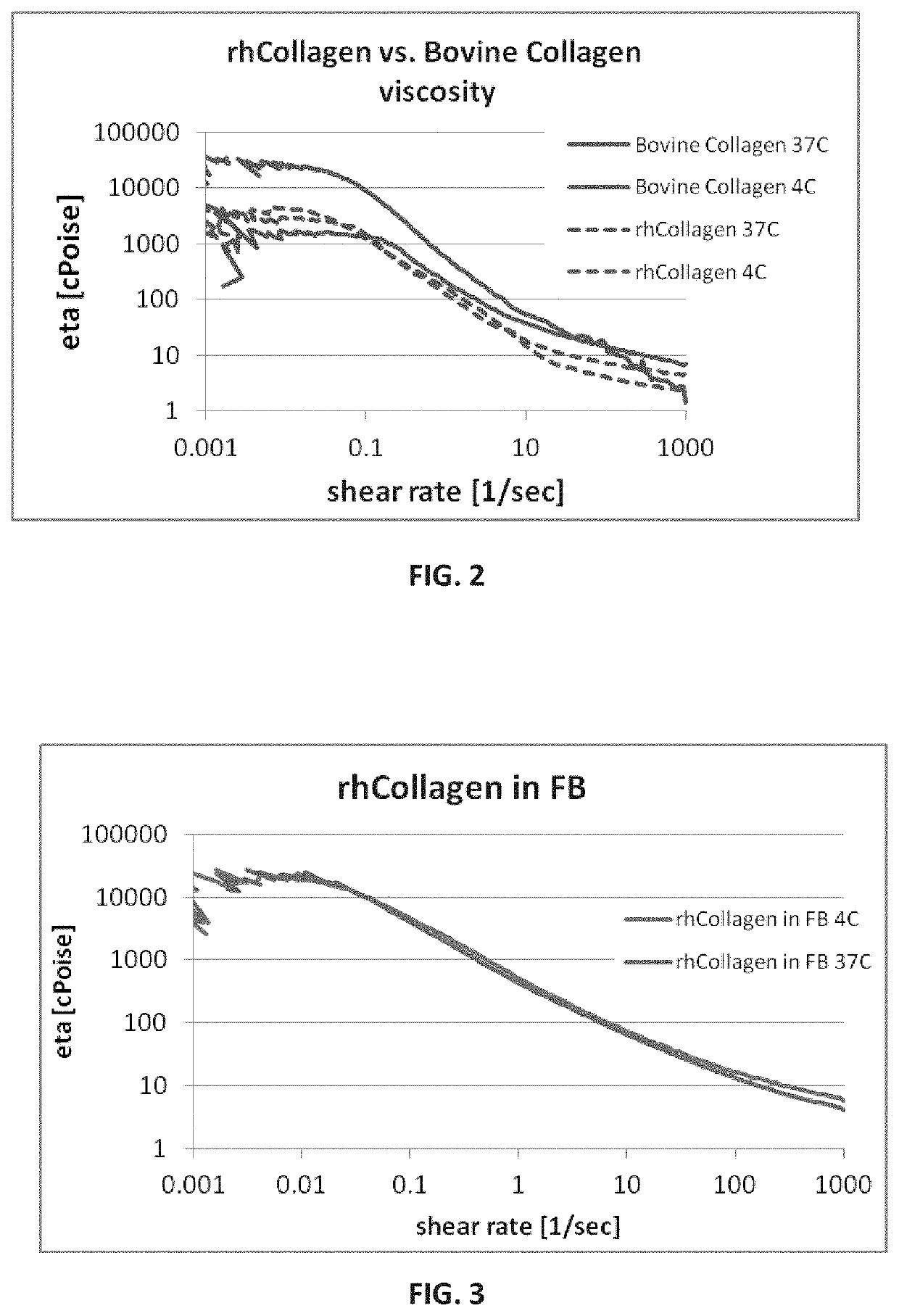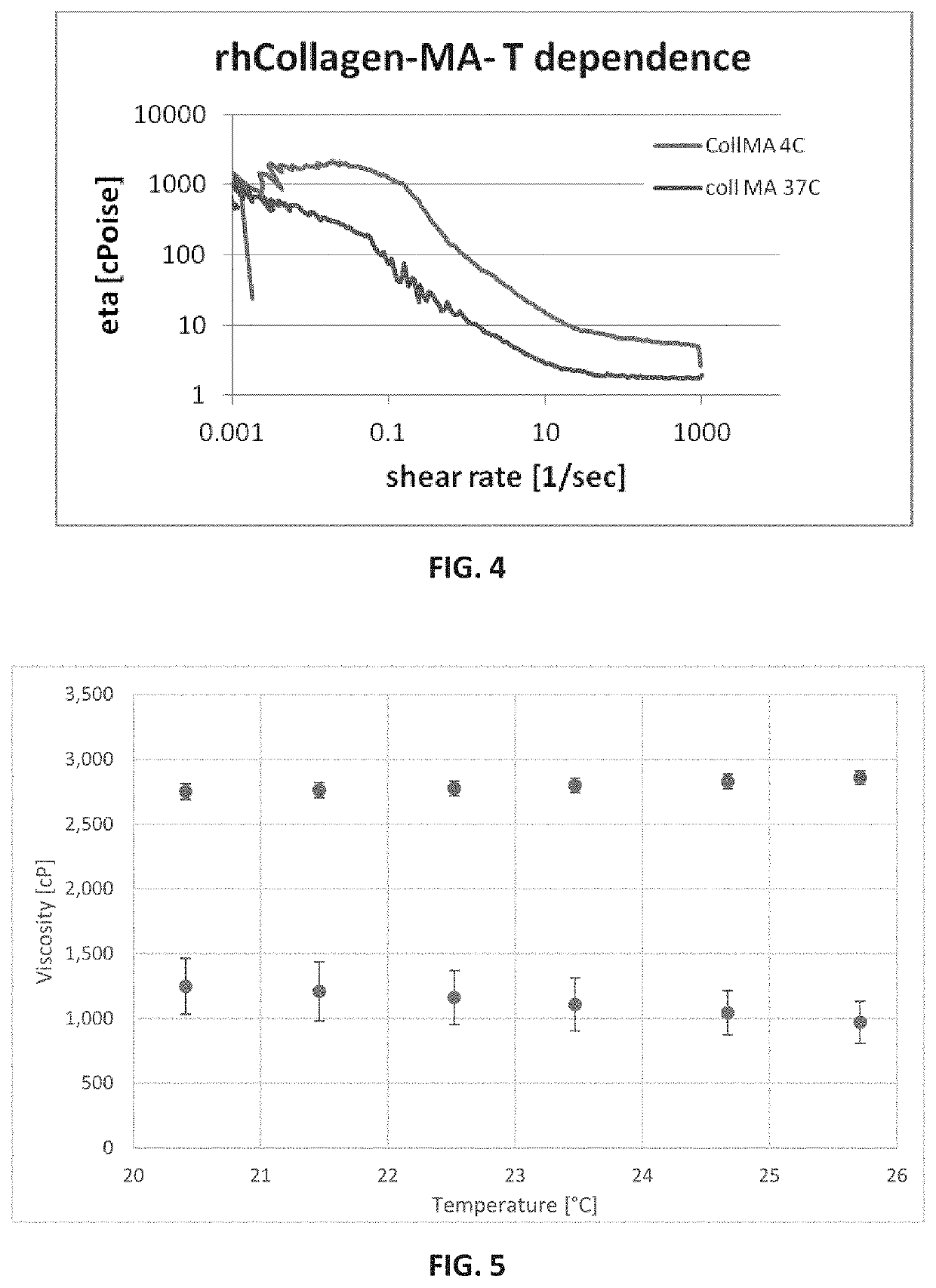Additive manufacturing using recombinant collagen-containing formulation
a technology of recombinant collagen and additive manufacturing, which is applied in the direction of additive manufacturing process, prosthesis, additive manufacturing apparatus, etc., can solve the problems of limited use of tissue extracted collagen for this purpose, affecting the use of 3d bioprinting, and spontaneous gel formation
- Summary
- Abstract
- Description
- Claims
- Application Information
AI Technical Summary
Benefits of technology
Problems solved by technology
Method used
Image
Examples
example 1
Methacrylation of rhCollagen
[0444]Fibrillar rhCollagen-methacrylamide and monomeric rhCollagen-methacrylamide were prepared by reaction of lysine and hydroxylysine residues of the collagen with methacrylic anhydride in aqueous medium as described below, and stored at 4° C. light protected until further use.
[0445]Fibrillar rhCollagen-Methacrylamide:
[0446]3 to 10 mg / mL fibrillar rhCollagen-methacrylamide (rhCollagen-MA) was synthesized either in a 1× washing buffer as described herein, a fibrillogenesis buffer as described herein or DDW, at room temperature (R.T.) or at 12° C.
[0447]In an exemplary procedure, fibrillar rhCollagen-MA was synthesized in DDW as follow: monomeric rhCollagen 3-4 mg / mL solution in 10 mM HCl, (Collage™) was mixed with fibrillogenesis buffer at 9:1 v / v ratio and stirred for 1 hour at R.T, receiving fibrils. The solution was centrifuged at 7500 rpm at 4° C. for 30 minutes, and the supernatant was thereafter discarded. The remaining pellet was re-suspended in eq...
example 2
Viscosity Measurements of rh-Collagen and rh-Collagen-MA
[0458]Solutions Preparation for Viscosity Measurements:
[0459]PureCol® and Collage™ in DPBS: 8 ml of monomeric collagen solutions (3 mg / mL in 10 mM HCl), either rhCollagen (Collage™) or bovine collagen (PureCol®) were neutralized by adding 1 mL of DPBS ×10. The solution was then brought to pH 7-7.5 by titration with 0.1N NaOH. Double distillated water (DDW) was then added to reach a final volume of 10 mL. Samples were incubated at 37° C. for at least 90 minutes before measurements were performed (either at 37° C. or 4° C.).
[0460]Collage™ in fibrillogenesis buffer: 9 ml of monomeric rhCollagen (Collage™) solution (3.79 mg / mL in 10 mM HCl) was neutralized by adding 1 mL of fibrillogenesis buffer. Samples were incubated at 37° C. for at least 90 minutes before measurements were performed (either at 37° C. or 4° C.).
[0461]Fibrillar rhCollagen-methacrylamide in DPBS: Lyophilized fibrillar rhCollagen-MA prepared in DDW and dialyzed vs...
example 3
Characterization of Hardened rh-Collagen-MA
[0470]rhCollagen-MA photocrosslinking for loss and storage moduli measurements:
[0471]rhCollagen-MA crosslinked scaffolds were formed in two different preparations, aimed to be examined in two individual experiments, respectively.
[0472]A photoinitiator 10% (v / v) stock solution was prepared as follows: Irgacure 2959 was dissolved in ethanol absolute / DDW 1:1 solution to a final concentration of 100 mg / mL.
[0473]In the first preparation, 1-2 wt % fibrillar rhCollagen-MA synthesized with 10-fold molar excess of the methacrylic reagent were dissolved in DPBS 0.1 M at room temperature, then Irgacure 2959 0.1% was added into 1 mL final volume of solution replicates which were injected into a discoid mold. Thereafter, curing process was performed from a distance of 1.5 cm for 7 and 10 seconds at an averaged intensity of 670 mW / cm2 using mercury light source, resulting in cross-linked scaffolds.
[0474]The second preparation included 2 different batches...
PUM
| Property | Measurement | Unit |
|---|---|---|
| Temperature | aaaaa | aaaaa |
| Temperature | aaaaa | aaaaa |
| Temperature | aaaaa | aaaaa |
Abstract
Description
Claims
Application Information
 Login to View More
Login to View More - R&D
- Intellectual Property
- Life Sciences
- Materials
- Tech Scout
- Unparalleled Data Quality
- Higher Quality Content
- 60% Fewer Hallucinations
Browse by: Latest US Patents, China's latest patents, Technical Efficacy Thesaurus, Application Domain, Technology Topic, Popular Technical Reports.
© 2025 PatSnap. All rights reserved.Legal|Privacy policy|Modern Slavery Act Transparency Statement|Sitemap|About US| Contact US: help@patsnap.com



